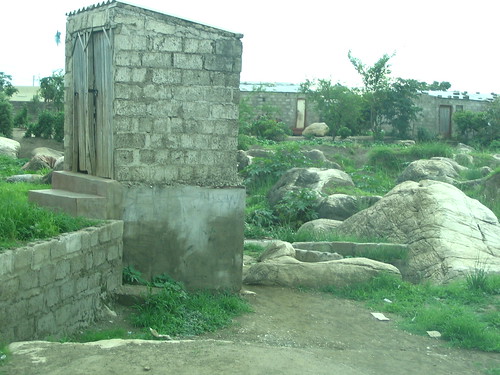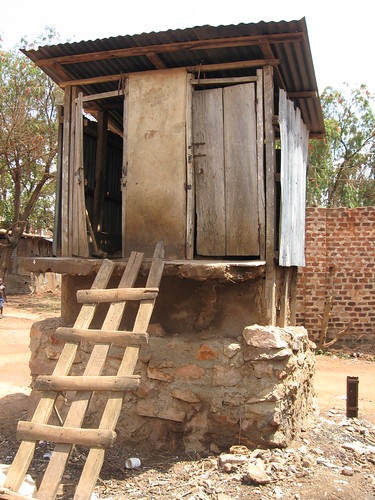- Forum
- categories
- Sanitation systems
- Toilets without urine diversion
- Innovations and research in toilet design
- Re: Breathable membrane enclosures for fecal sludge stabilization (University of Delaware, USA)
Re: Breathable membrane enclosures for fecal sludge stabilization (University of Delaware, USA)
82.6k views
- former member
-
Topic AuthorLess
- Posts: 101
- Likes received: 3
Re: Write-up from webinar 6 - Vapor-permeable membranes (Steve Dentel, University of Delaware, USA)
Arno/Håkan,
This is not the place to argue about the precautionary principle, but I think this is an example of taking it to extremes. As I noted, the external surfaces of the fabrics are not made of Teflon or other hydrophobic substances, so abrasion is not a likely issue. Nonetheless, I cannot prove it will not happen under some conditions that you may come up with. That any abrasion products themselves might be harmful is also not established.
The material allows water penetration but no penetration of any water-borne contaminants, and the water transfer is rapid enough that the pit surface can release all the water contributed by a family's feces and urine. These two combined benefits are significant, and they are not attained with bentonite or porous brickwork.
Certainly we can imagine cases where an entire fabric enclosure, with its hydrophobic membrane, is not returned for deposit and ends up buried, where its nondegradable membrane will remain indefinitely. This possibility, which I see as exemplifying your concerns, illustrates issues inherent in the precautionary principle: it asks that a hypothesis be proven under an infinite number of conditions, and it does not consider societal or environmental benefits relative to these (even unlikely) possible harms.
I am looking forward to your replies, but I am not sure we will reach mutual agreement on these questions.
++++++++
Note by moderators: This post was made by a former user with the login name skdentel who is no longer a member of this discussion forum.
This is not the place to argue about the precautionary principle, but I think this is an example of taking it to extremes. As I noted, the external surfaces of the fabrics are not made of Teflon or other hydrophobic substances, so abrasion is not a likely issue. Nonetheless, I cannot prove it will not happen under some conditions that you may come up with. That any abrasion products themselves might be harmful is also not established.
The material allows water penetration but no penetration of any water-borne contaminants, and the water transfer is rapid enough that the pit surface can release all the water contributed by a family's feces and urine. These two combined benefits are significant, and they are not attained with bentonite or porous brickwork.
Certainly we can imagine cases where an entire fabric enclosure, with its hydrophobic membrane, is not returned for deposit and ends up buried, where its nondegradable membrane will remain indefinitely. This possibility, which I see as exemplifying your concerns, illustrates issues inherent in the precautionary principle: it asks that a hypothesis be proven under an infinite number of conditions, and it does not consider societal or environmental benefits relative to these (even unlikely) possible harms.
I am looking forward to your replies, but I am not sure we will reach mutual agreement on these questions.
++++++++
Note by moderators: This post was made by a former user with the login name skdentel who is no longer a member of this discussion forum.
Please Log in to join the conversation.
You need to login to replyRe: Write-up from webinar 6 - Vapor-permeable membranes (Steve Dentel, University of Delaware, USA)
Steve/Håkan
Common sense says we shouldn't be putting non-degradable compounds into the soil especially if it is part of a potential food-sanitation-fertiliser-food value chain. For communities to get a license to use PTFE teflon bags, EIAs (Environmental Impact Assessments) would be necessary. And stakeholders will use the common sense or precautionary principle. The question is whether we can make these bags out of other materials that can sooner or later breakdown in the environment. eg Green Coat www.polymateltd.com/files/6_GreenCoat.pdf
Bentonite is commonly used to contain buried solid waste and prevent it from contaminating the ground water. If the purpose is dewatering of sewage in a pit latrine, there may be alternatives available - the first one that comes to mind is to reduce the volume of water in the flush water. The Sulabh silos in India dewater through porous brickwork and then seep into bentonite in areas where groundwater is vulnerable. Dry toilets with shallow pits that compost using biologically active soil should be considered as an alternative (so called Fossa alterna) in vulnerable soil-ground water zones.
Regards
--Arno
Arno Rosemarin
Stockholm Environment Institute
Common sense says we shouldn't be putting non-degradable compounds into the soil especially if it is part of a potential food-sanitation-fertiliser-food value chain. For communities to get a license to use PTFE teflon bags, EIAs (Environmental Impact Assessments) would be necessary. And stakeholders will use the common sense or precautionary principle. The question is whether we can make these bags out of other materials that can sooner or later breakdown in the environment. eg Green Coat www.polymateltd.com/files/6_GreenCoat.pdf
Bentonite is commonly used to contain buried solid waste and prevent it from contaminating the ground water. If the purpose is dewatering of sewage in a pit latrine, there may be alternatives available - the first one that comes to mind is to reduce the volume of water in the flush water. The Sulabh silos in India dewater through porous brickwork and then seep into bentonite in areas where groundwater is vulnerable. Dry toilets with shallow pits that compost using biologically active soil should be considered as an alternative (so called Fossa alterna) in vulnerable soil-ground water zones.
Regards
--Arno
Arno Rosemarin
Stockholm Environment Institute
Arno Rosemarin PhD
Stockholm Environment Institute
This email address is being protected from spambots. You need JavaScript enabled to view it.
www.sei.org
www.ecosanres.org
Stockholm Environment Institute
This email address is being protected from spambots. You need JavaScript enabled to view it.
www.sei.org
www.ecosanres.org
Please Log in to join the conversation.
You need to login to reply- HakanJonsson
-
Less
- Posts: 12
- Karma: 3
- Likes received: 10
Re: Write-up from webinar 6 - Vapor-permeable membranes (Steve Dentel, University of Delaware, USA)
Dear Steve,
I worry both about the PTFE, which is not biodegradable and about the PFOAs, which exist both both in the production and when the material is thermally degraded. We do know that the material will wear. I mentioned the example of the compost with semipermeable membrane in Sala and I think we all have had to change our frying pans due to the non-stick layer, of PTFE, being worn out. And this is in spite of us using wooden and plastic tools, as we know that the surface is sensitive to wear. Faecal sludge will contain some sand and other hard particles, which will cause wear and remove PTFE particle from the surface. Some of these small partilces in the soil will be exposed to sunlight. I do not know if this means that they will degrade in the UV-light. But the fact that we are spreading a slow or non-degradable man made substance in nature without knowing how it is removed or accumulated goes, as I see it, against the precaution principle. So it worries me.
In the 50-ies and 60ies we spread lots of cadmium, also a non-degradable substance, as a pollution in chemical fertilizer in Sweden. Now several percent of the old age Swedish population have kidneys that leaks protein. Due to other soils in many other european countries, they still spread fertilizers with lots of cadmium, around 180 mg Cd/kg P and are not yet worried. The fertilizers in Sweden are around 3-10 mg Cd/kg P and to protect health we want strict restrictions on cadmium on all of EU. However, due to the economic interestes involved, the other countries do not want to put restrictions on cadmium.
So even though the precaustion principle means we should wait with implementation until we now how large the risks are, I know that this is not how the world works at present.
Best wishes,
Håkan
I worry both about the PTFE, which is not biodegradable and about the PFOAs, which exist both both in the production and when the material is thermally degraded. We do know that the material will wear. I mentioned the example of the compost with semipermeable membrane in Sala and I think we all have had to change our frying pans due to the non-stick layer, of PTFE, being worn out. And this is in spite of us using wooden and plastic tools, as we know that the surface is sensitive to wear. Faecal sludge will contain some sand and other hard particles, which will cause wear and remove PTFE particle from the surface. Some of these small partilces in the soil will be exposed to sunlight. I do not know if this means that they will degrade in the UV-light. But the fact that we are spreading a slow or non-degradable man made substance in nature without knowing how it is removed or accumulated goes, as I see it, against the precaution principle. So it worries me.
In the 50-ies and 60ies we spread lots of cadmium, also a non-degradable substance, as a pollution in chemical fertilizer in Sweden. Now several percent of the old age Swedish population have kidneys that leaks protein. Due to other soils in many other european countries, they still spread fertilizers with lots of cadmium, around 180 mg Cd/kg P and are not yet worried. The fertilizers in Sweden are around 3-10 mg Cd/kg P and to protect health we want strict restrictions on cadmium on all of EU. However, due to the economic interestes involved, the other countries do not want to put restrictions on cadmium.
So even though the precaustion principle means we should wait with implementation until we now how large the risks are, I know that this is not how the world works at present.
Best wishes,
Håkan
Please Log in to join the conversation.
You need to login to reply- former member
-
Topic AuthorLess
- Posts: 101
- Likes received: 3
Re: Write-up from webinar 6 - Vapor-permeable membranes (Steve Dentel, University of Delaware, USA)
Hakan, I am trying to understand your opinion but it is difficult. PTFE, firstly, is different from the lower molecular weight, bioaccumulative PFOA chemicals that I believe you are referring to. PFOAs are used in the manufacture of PTFE and other fluorinated polymers, but you are indicating that PTFE degrades into these or similar chemicals. I have not found any evidence of that in the scientific literature, with the exception of some studies on PTFE degradation in cookware at quite high temperatures. Our applications are not going to be much above natural temperatures.
You also indicate that PTFE is nonbiodegradable, which doesn't seem consistent with your concern about its degradation products. I do know that Gore-Tex and other such fabrics include a thin membrane of the hydrophobic material, but outer layers of other materials. These outer layers can be treated to be UV-resistant, but over time they are probably photo-degraded in any case. This is probably what you observe at Sala.
We do not envision any applications like the Gore-Tex composting method, which exposes the fabric to direct sunlight. So even the other materials are unlikely to photodegrade at any appreciable rate.
As I stated previously, these fabrics will be reusable and, if it is determined that they pose an environmental risk (which I do not believe), they could be returned for a deposit when a new one is purchased.
So I do not believe there is a significant environmental risk from the use of these membranes. Even if there were, it must be compared to the environmental benefits the fabric's use should offer, and to the massive use of similar plastics in less beneficial applications. But I should repeat, I can find no convincing evidence that PTFE degrades to the types of chemicals you are referring to.
++++++++
Note by moderators: This post was made by a former user with the login name skdentel who is no longer a member of this discussion forum.
You also indicate that PTFE is nonbiodegradable, which doesn't seem consistent with your concern about its degradation products. I do know that Gore-Tex and other such fabrics include a thin membrane of the hydrophobic material, but outer layers of other materials. These outer layers can be treated to be UV-resistant, but over time they are probably photo-degraded in any case. This is probably what you observe at Sala.
We do not envision any applications like the Gore-Tex composting method, which exposes the fabric to direct sunlight. So even the other materials are unlikely to photodegrade at any appreciable rate.
As I stated previously, these fabrics will be reusable and, if it is determined that they pose an environmental risk (which I do not believe), they could be returned for a deposit when a new one is purchased.
So I do not believe there is a significant environmental risk from the use of these membranes. Even if there were, it must be compared to the environmental benefits the fabric's use should offer, and to the massive use of similar plastics in less beneficial applications. But I should repeat, I can find no convincing evidence that PTFE degrades to the types of chemicals you are referring to.
++++++++
Note by moderators: This post was made by a former user with the login name skdentel who is no longer a member of this discussion forum.
The following user(s) like this post: JKMakowka
Please Log in to join the conversation.
You need to login to reply- HakanJonsson
-
Less
- Posts: 12
- Karma: 3
- Likes received: 10
Re: Write-up from webinar 6 - Vapor-permeable membranes (Steve Dentel, University of Delaware, USA)
Steve, I am still not convinced.
My reasons, PTFE is a material like Gore-tex. This type of material is used e.g. in composting under semi-permeable cover, which normally has a roof made up of a Goretex like material. This is really good for decreasing the odour and emissions from the compost. There is a semi-permeable compost like this this in Sala. After about 10 years, the semi-permeable roof was almost see-through. This was in spite of nothing but air, rain and sun. The PTFE probably bit by bit had dripped onto the compost. I believe that the wear of the bags will be much larger.
As far as I know, PTFE is non-biodegradable and it, or at least similar perfluorinated chemicals, are bioaccumulating. Their levels in blood samples are, as far as I know, increasing. Even if the wear is small, it gives non-degradable substances ending up in arable soil. But of course the use of Gore-tex in shoes and clothes should also be a big concern then.
My reasons, PTFE is a material like Gore-tex. This type of material is used e.g. in composting under semi-permeable cover, which normally has a roof made up of a Goretex like material. This is really good for decreasing the odour and emissions from the compost. There is a semi-permeable compost like this this in Sala. After about 10 years, the semi-permeable roof was almost see-through. This was in spite of nothing but air, rain and sun. The PTFE probably bit by bit had dripped onto the compost. I believe that the wear of the bags will be much larger.
As far as I know, PTFE is non-biodegradable and it, or at least similar perfluorinated chemicals, are bioaccumulating. Their levels in blood samples are, as far as I know, increasing. Even if the wear is small, it gives non-degradable substances ending up in arable soil. But of course the use of Gore-tex in shoes and clothes should also be a big concern then.
Please Log in to join the conversation.
You need to login to reply- Elisabeth
-
- User is blocked
- Freelance consultant since 2012
Less- Posts: 3372
- Karma: 54
- Likes received: 932
Re: Write-up from webinar 6 - Vapor-permeable membranes (Steve Dentel, University of Delaware, USA)
Dear all,
For the benefit of readers with slow internet connection (or unable to view Youtube videos), I am providing you here with a write-up of the presentation by Steve Dentel and the discussion on 25 February 2014 during webinar number 6 (*).
The topic of his presentation was:
Vapor-permeable membranes: Three potential uses in faecal sludge management for safe sanitation and resource recovery (10 minutes)
By Steven K. Dentel, Department of Civil and Environmental Engineering, University of Delaware, Newark, USA
You can watch Steve's presentation here: (**)
Powerpoint slides from his presentation are available here:
Some key points from his presentation according to my notes:
This is broadly what was discussed:
(1)
Hakan Jönsson asked: "Have you looked at the environmental impact of this type of hydrophobic substances if they get into the environment (they are difficult to degrade and bio-accumulate) - as this is a concern with these hydrophobic substances in Sweden?"
Steve’s answer: "This issue is quite unrelated to our research (might be more relevant during the production of these membranes?). The fabric would be used multiple times and could/should be sent back to the manufacturer where it could be recycled or properly disposed. These materials are widely used in camping wear, boat sails. We think that the small amount used in our applications would not cause more problems than it solves (i.e. less pollution from faecal matter)."
(2)
Hakan Jönsson asked: "But would this hydrophobic material not get into the fertiliser?"
Steve’s answer: "No, it’s like a large bag; the bas is emptied out when full; the dried material could be composted and used as fertilizer."
(3)
I asked: "You mentioned “multiple use”, how often can be bag be used?"
Steve’s answer: "In the graph on slide 4 I showed an example with 5 times of use – it lost 3% of the permeability only; therefore could be used almost indefinitely, e.g. if it takes three months to fill the bag – it could be used for many years."
(4)
Richard (Chip) Fisher: "At what conditions do you run your drying tests? (temperatures on either side of membrane, relative humidity, etc.). Do you have to supply heat to the waste-side of the membrane?"
Steve’s answer: (I wasn’t able to write it all down correctly, listen to it here if you can: )
In brief, his answer explained the effects of different water vapour pressures (lower temperature = lower water pressure); water vapour would move from the faecal sludge to the cooler outer side; have done many tests at room temperature, elevated temperature, temperature gradients… best way to use the membrane is to have faecal sludge on one side and air on the other side, rather than relying on the small temperature difference that you would find e.g. in a water-logged soil for a pit latrine (therefore, application 3 in his presentation is more promising than application 1).
I hope you found this write-up useful (particularly if Youtube is banned in your country). Please don’t hesitate to put any follow-up questions, comments or clarifications into this thread. Thanks again to Steve Dentel for giving this presentation at this webinar!
Regards,
Elisabeth
(*) More information about these webinars is available in this thread here:
forum.susana.org/forum/categories/139-in...n-now-available#7519
A Playlist with all the videos from our webinars so far is available here:
www.youtube.com/playlist?list=PL0gMdVBup...ymOPomtqL_XYT5YtLTSK
(**) If you have any problems with displaying the videos, please take a look at this FAQ for a possible solution:
forum.susana.org/forum/categories/135-qu...--but-it-doesnt-work
For the benefit of readers with slow internet connection (or unable to view Youtube videos), I am providing you here with a write-up of the presentation by Steve Dentel and the discussion on 25 February 2014 during webinar number 6 (*).
The topic of his presentation was:
Vapor-permeable membranes: Three potential uses in faecal sludge management for safe sanitation and resource recovery (10 minutes)
By Steven K. Dentel, Department of Civil and Environmental Engineering, University of Delaware, Newark, USA
You can watch Steve's presentation here: (**)
Powerpoint slides from his presentation are available here:
This attachment is hidden for guests.
Please log in or register to see it.
Please log in or register to see it.
Some key points from his presentation according to my notes:
- Only water vapour can go through the membrane; water can “dry” through the fabric (the fabric contains the membrane).
- The membrane for drying can be used for treating/drying faecal sludge or other waste materials – in fact anything that contains water.
- When the water vapour leaves the faecal sludge or other liquid, it leaves behind anything that was dissolved in the water; it is essentially a water purification process – called membrane distillation (this is how Steve’s research started out).
- The membrane is made of a non-stick material like Teflon, PTFE.
- While the vapour is going out of the faecal sludge (from left to right on slide 2), air is travelling in the opposite direction of the vapour (i.e. from the outside into the fabric and into the faecal sludge) and can therefore maintain aerobic conditions in the faecal sludge.
- The faecal sludge doesn’t stick to the membrane, it doesn’t clog the membrane. People don’t believe this so Steve’s team keeps having to establich more evidence for this (i.e. that the fabric doesn’t clog up).
- Steve’s team has dried materials on these fabrics five consecutive times, with only a 3% loss of flux per cycle (see slide number 4).
- The membrane enclosure can be used many times – they are quite reusable which brings down the cost a lot, he said.
- Steve showed three possible applications. The third application is the one they’re moving ahead with in the most direct way (trials planned with WaterAid in India). It’s about a latrine that is installed on the roof due to lack of space; there would be drum at ground level that is lined with the fabric that contains the membrane. There would be sand between the fabric and the inner side of the drum so that there is an air gap (so that air can go out and the material can dry). When the barrel is full with (dried) faecal sludge, the membrane sack would be removed, emptied and used again. The clean water that is infiltrating through the membrane (in the form of vapour) would infiltrate into the ground or could be used for some other purposes as it is totally clean.
- These membrane fabrics would allow for more rapid drying, they allow air to enter, therefore we can recover water (amount is depending on how much urine is involved). Most important amount for recovery is however not the water but the material (dried faecal sludge) that can be composted and used as fertiliser.
- Steve said: "We are looking for a very simple, low maintenance, low-cost technology – easy to apply (we want this to be a “viral technology”, something that is so simple and easy to use)."
This is broadly what was discussed:
(1)
Hakan Jönsson asked: "Have you looked at the environmental impact of this type of hydrophobic substances if they get into the environment (they are difficult to degrade and bio-accumulate) - as this is a concern with these hydrophobic substances in Sweden?"
Steve’s answer: "This issue is quite unrelated to our research (might be more relevant during the production of these membranes?). The fabric would be used multiple times and could/should be sent back to the manufacturer where it could be recycled or properly disposed. These materials are widely used in camping wear, boat sails. We think that the small amount used in our applications would not cause more problems than it solves (i.e. less pollution from faecal matter)."
(2)
Hakan Jönsson asked: "But would this hydrophobic material not get into the fertiliser?"
Steve’s answer: "No, it’s like a large bag; the bas is emptied out when full; the dried material could be composted and used as fertilizer."
(3)
I asked: "You mentioned “multiple use”, how often can be bag be used?"
Steve’s answer: "In the graph on slide 4 I showed an example with 5 times of use – it lost 3% of the permeability only; therefore could be used almost indefinitely, e.g. if it takes three months to fill the bag – it could be used for many years."
(4)
Richard (Chip) Fisher: "At what conditions do you run your drying tests? (temperatures on either side of membrane, relative humidity, etc.). Do you have to supply heat to the waste-side of the membrane?"
Steve’s answer: (I wasn’t able to write it all down correctly, listen to it here if you can: )
In brief, his answer explained the effects of different water vapour pressures (lower temperature = lower water pressure); water vapour would move from the faecal sludge to the cooler outer side; have done many tests at room temperature, elevated temperature, temperature gradients… best way to use the membrane is to have faecal sludge on one side and air on the other side, rather than relying on the small temperature difference that you would find e.g. in a water-logged soil for a pit latrine (therefore, application 3 in his presentation is more promising than application 1).
I hope you found this write-up useful (particularly if Youtube is banned in your country). Please don’t hesitate to put any follow-up questions, comments or clarifications into this thread. Thanks again to Steve Dentel for giving this presentation at this webinar!
Regards,
Elisabeth
(*) More information about these webinars is available in this thread here:
forum.susana.org/forum/categories/139-in...n-now-available#7519
A Playlist with all the videos from our webinars so far is available here:
www.youtube.com/playlist?list=PL0gMdVBup...ymOPomtqL_XYT5YtLTSK
(**) If you have any problems with displaying the videos, please take a look at this FAQ for a possible solution:
forum.susana.org/forum/categories/135-qu...--but-it-doesnt-work
Dr. Elisabeth von Muench
Freelance consultant on environmental and climate projects
Freelance consultant on environmental and climate projects
This message has an attachment file.
Please log in or register to see it.
Please Log in to join the conversation.
You need to login to reply- former member
-
Topic AuthorLess
- Posts: 101
- Likes received: 3
Re: Breathable membrane enclosures for fecal sludge stabilization (University of Delaware, USA)
Oh, and I didn't reply to all your questions.
- on the fabric strength: the membrane itself is not very strong, but the fabric is a laminate with supporting layer on each side of the membrane. You can choose from different weaves and thicknesses, so a very strong material is quite possible. They make boat sails out of it, for example.
- I have imagined emptying out the fabric enclosure on site, assuming it's dried enough to be non-objectionable, but your idea of an exchange might be better. That's a question for the people implementing this on-location, so we'll bring it up.
Thanks again for your contribution!
Steve
++++++++
Note by moderators: This post was made by a former user with the login name skdentel who is no longer a member of this discussion forum.
- on the fabric strength: the membrane itself is not very strong, but the fabric is a laminate with supporting layer on each side of the membrane. You can choose from different weaves and thicknesses, so a very strong material is quite possible. They make boat sails out of it, for example.
- I have imagined emptying out the fabric enclosure on site, assuming it's dried enough to be non-objectionable, but your idea of an exchange might be better. That's a question for the people implementing this on-location, so we'll bring it up.
Thanks again for your contribution!
Steve
++++++++
Note by moderators: This post was made by a former user with the login name skdentel who is no longer a member of this discussion forum.
Please Log in to join the conversation.
You need to login to reply- former member
-
Topic AuthorLess
- Posts: 101
- Likes received: 3
Re: Breathable membrane enclosures for fecal sludge stabilization (University of Delaware, USA)
Krischan,
Thanks for your thoughts!
The limiting factor with these membranes is how fast the gas can get through the membrane. We've measured this for water vapor using different fabrics and temperatures. It's fast enough for drying purposes (depending, of course, on how much liquid is added and the amount of fabric area). But we think the air supply for composting is more than we can expect under the conditions we foresee. We're measuring this in experiments currently.
There are "industrial" scale composting processes that use these types of breathable membrane fabrics already - you can learn about them, for example, by searching the terms "Gore" and "cover." These require mechanical aerators to speed up the process, and the fabric is only used on top of the compost windrow. The membrane is not for drying purposes, but to prevent condensation. Our approach is less hurried: we want a passive process that, in the time period of filling the enclosure, allows drying so the volume is filled with fecal solids rather than liquid.
In other words, I think composting may be helped by this breathable fabric, but it would still require some other means of air circulation (like the raised vent in some commercial home-scale waste composters). If this is being done, we're not sure how much assistance the breathable fabric provides. I feel like there's a lot of work that still needs to be done! (see more in the next comment....)
++++++++
Note by moderators: This post was made by a former user with the login name skdentel who is no longer a member of this discussion forum.
Thanks for your thoughts!
The limiting factor with these membranes is how fast the gas can get through the membrane. We've measured this for water vapor using different fabrics and temperatures. It's fast enough for drying purposes (depending, of course, on how much liquid is added and the amount of fabric area). But we think the air supply for composting is more than we can expect under the conditions we foresee. We're measuring this in experiments currently.
There are "industrial" scale composting processes that use these types of breathable membrane fabrics already - you can learn about them, for example, by searching the terms "Gore" and "cover." These require mechanical aerators to speed up the process, and the fabric is only used on top of the compost windrow. The membrane is not for drying purposes, but to prevent condensation. Our approach is less hurried: we want a passive process that, in the time period of filling the enclosure, allows drying so the volume is filled with fecal solids rather than liquid.
In other words, I think composting may be helped by this breathable fabric, but it would still require some other means of air circulation (like the raised vent in some commercial home-scale waste composters). If this is being done, we're not sure how much assistance the breathable fabric provides. I feel like there's a lot of work that still needs to be done! (see more in the next comment....)
++++++++
Note by moderators: This post was made by a former user with the login name skdentel who is no longer a member of this discussion forum.
Please Log in to join the conversation.
You need to login to replyRe: Breathable membrane enclosures for fecal sludge stabilization (University of Delaware, USA)
This might indeed be a nice improvement for double vault UDDTs to allow better and faster drying. I also like the idea of using the bags for emptying, but rough handling by waste disposal service providers will be a problem as well as finding a feasible service chain for re-using the bags (maybe a something like a bottle deposit, e.g. you need to buy the bag but get a refund if you return it undamaged?).
Another interesting application would be to build the bag in a way that would allow physical turning over (similar to how you turn a compost pile) in a totally safe way for the person doing it e.g. no contact with the feces.
Hmm... in general have you looked into autothermophilic composting and how a gas-permeable membrane could be utilized in it? Such composting obviously needs a good oxygen supply at which which a comparted membrane enclosure could help.
Another interesting application would be to build the bag in a way that would allow physical turning over (similar to how you turn a compost pile) in a totally safe way for the person doing it e.g. no contact with the feces.
Hmm... in general have you looked into autothermophilic composting and how a gas-permeable membrane could be utilized in it? Such composting obviously needs a good oxygen supply at which which a comparted membrane enclosure could help.
Please Log in to join the conversation.
You need to login to reply- former member
-
Topic AuthorLess
- Posts: 101
- Likes received: 3
Re: Breathable membrane enclosures for fecal sludge stabilization (University of Delaware, USA)
Hi all,
Followers of this topic may want to tune into the upcoming Webinar (number 6 in the series) - this one's titled “Productive Sanitation.” It has three presentations, all likely to be quite interesting.
My presentation, third in the Webinar, is titled Vapor-permeable membranes: Three potential uses in faecal sludge management for safe sanitation and resource recovery.
The Webinar is happening Tuesday Feb. 25th 2014, 16:30 - 17:15 CET.
CET is "Central European Time." To reliably convert to your local time, go to www.timeanddate.com/worldclock/converter.html .
More details are available here on the forum:
forum.susana.org/forum/categories/139-in...5-february-2014#7239 .
You won't have to download any software to attend. Simply go to this website: seint.adobeconnect.com/seiwebinar/.
However, you must obtain the password to enter the room. To obtain the password, e-mail Elisabeth von Muench: This email address is being protected from spambots. You need JavaScript enabled to view it.. Do this in advance!
I hope you'll be participating!
Steve
++++++++
Note by moderators: This post was made by a former user with the login name skdentel who is no longer a member of this discussion forum.
Followers of this topic may want to tune into the upcoming Webinar (number 6 in the series) - this one's titled “Productive Sanitation.” It has three presentations, all likely to be quite interesting.
My presentation, third in the Webinar, is titled Vapor-permeable membranes: Three potential uses in faecal sludge management for safe sanitation and resource recovery.
The Webinar is happening Tuesday Feb. 25th 2014, 16:30 - 17:15 CET.
CET is "Central European Time." To reliably convert to your local time, go to www.timeanddate.com/worldclock/converter.html .
More details are available here on the forum:
forum.susana.org/forum/categories/139-in...5-february-2014#7239 .
You won't have to download any software to attend. Simply go to this website: seint.adobeconnect.com/seiwebinar/.
However, you must obtain the password to enter the room. To obtain the password, e-mail Elisabeth von Muench: This email address is being protected from spambots. You need JavaScript enabled to view it.. Do this in advance!
I hope you'll be participating!
Steve
++++++++
Note by moderators: This post was made by a former user with the login name skdentel who is no longer a member of this discussion forum.
Please Log in to join the conversation.
You need to login to reply- former member
-
Topic AuthorLess
- Posts: 101
- Likes received: 3
Re: Breathable membrange grant by Steve Dentel - Phase 2 extention
Arno,
- Thanks for all the questions and comments. I'll start with some responses here, and will probably have more later. I'll attach our Phase I report to this posting.
- On the breathable membranes: technically, these are fabric laminates with the functional membrane sandwiched in the middle. So there can be differences in the membrane itself, and also in the fabric layers on either side. Plus, the membrane itself is a hydrophobic weave (often PTFE) but either the individual fibers or the entire membrane may be coated with an additional polymer. So there are numerous variables. We have had samples from Gore, DuPont, and GE of various types. Currently we are working with a DuPont product (1073B) plus some GE fabrics called eVent (R); all of these are significantly better than earlier products we tested. The DuPont product is not too exciting to look at - it's similar to the Tyvek(R) used for express mailing. I'll post a picture of one of the eVent products later that shows the three layers, because that's instructive.
- What does breathable mean? This type of material is used for tents and winter camping garments. When it rains, the liquid water will not go through it. But when you sweat, the vapor can escape because vapors go through the membrane (and that's aided by the warmer temperature on the interior side). The membrane is very hydrophobic, which is why the liquid water is repelled.
- We discovered that the hydrophobicity means you can put sludge right up against the fabric and it will not clog the membrane. That's because the sludge doesn't come in much contact with the membrane: just like the non-stick surface of a Teflon (R) pan, which is PTFE, the stuff "beads up" and separates from the membrane. After we dry sludge in contact with the membrane, it separates perfectly, leaving a clean membrane, for multiple cycles of use. This surprised us initially, and reviewers still don't believe it, so a lot of our work is still collecting lots of evidence to this point.
- We first envisioned using the fabric to line or enclose latrine pits. The lower vapor pressure, and perhaps lower temperature, on the outside of the membrane should drive water out of the pit. The fecal sludge dries, with the benefit being that nothing but water vapor escapes. This protects ground water or serves to protect the waste from floodwater incursion, but allows drying at other times.
- But the better use, we now believe, is for places where fecal sludge is collected above-ground. I'm not sure why you think of this as a desperate measure - it's simply a different approach, which can protect groundwater, allow easier access to the waste, and encourage air drying. We're collaborating with WaterAid India in urban areas where there's simply no open area for new pits, and latrines are actually being constructed on the roofs of homes (see below). In any configuration like this, a breathable fabric should enclose the waste, allowing only water vapor to escape (thus drying) and protecting from vermin. The fabric is actually strong enough that we may design enclosures that also facilitate emptying by pulling out an entire "bag" at once.
- But right now we're in a transition period. The BMGF wanted more proof of non-clogging, which we now have, and we are using our vapor flux rates for scale-up calculations. I expect to be in New Delhi next month as we plan our tests with WaterAid.
By the way, our first expected collaborator did not get Phase II support from the Gates Foundation, so our own Phase 2 project brief is obsolete. What I've posted here is a better update I think, and I'll post again as we make more progress.
++++++++
Note by moderators: This post was made by a former user with the login name skdentel who is no longer a member of this discussion forum.
- Thanks for all the questions and comments. I'll start with some responses here, and will probably have more later. I'll attach our Phase I report to this posting.
- On the breathable membranes: technically, these are fabric laminates with the functional membrane sandwiched in the middle. So there can be differences in the membrane itself, and also in the fabric layers on either side. Plus, the membrane itself is a hydrophobic weave (often PTFE) but either the individual fibers or the entire membrane may be coated with an additional polymer. So there are numerous variables. We have had samples from Gore, DuPont, and GE of various types. Currently we are working with a DuPont product (1073B) plus some GE fabrics called eVent (R); all of these are significantly better than earlier products we tested. The DuPont product is not too exciting to look at - it's similar to the Tyvek(R) used for express mailing. I'll post a picture of one of the eVent products later that shows the three layers, because that's instructive.
- What does breathable mean? This type of material is used for tents and winter camping garments. When it rains, the liquid water will not go through it. But when you sweat, the vapor can escape because vapors go through the membrane (and that's aided by the warmer temperature on the interior side). The membrane is very hydrophobic, which is why the liquid water is repelled.
- We discovered that the hydrophobicity means you can put sludge right up against the fabric and it will not clog the membrane. That's because the sludge doesn't come in much contact with the membrane: just like the non-stick surface of a Teflon (R) pan, which is PTFE, the stuff "beads up" and separates from the membrane. After we dry sludge in contact with the membrane, it separates perfectly, leaving a clean membrane, for multiple cycles of use. This surprised us initially, and reviewers still don't believe it, so a lot of our work is still collecting lots of evidence to this point.
- We first envisioned using the fabric to line or enclose latrine pits. The lower vapor pressure, and perhaps lower temperature, on the outside of the membrane should drive water out of the pit. The fecal sludge dries, with the benefit being that nothing but water vapor escapes. This protects ground water or serves to protect the waste from floodwater incursion, but allows drying at other times.
- But the better use, we now believe, is for places where fecal sludge is collected above-ground. I'm not sure why you think of this as a desperate measure - it's simply a different approach, which can protect groundwater, allow easier access to the waste, and encourage air drying. We're collaborating with WaterAid India in urban areas where there's simply no open area for new pits, and latrines are actually being constructed on the roofs of homes (see below). In any configuration like this, a breathable fabric should enclose the waste, allowing only water vapor to escape (thus drying) and protecting from vermin. The fabric is actually strong enough that we may design enclosures that also facilitate emptying by pulling out an entire "bag" at once.
- But right now we're in a transition period. The BMGF wanted more proof of non-clogging, which we now have, and we are using our vapor flux rates for scale-up calculations. I expect to be in New Delhi next month as we plan our tests with WaterAid.
By the way, our first expected collaborator did not get Phase II support from the Gates Foundation, so our own Phase 2 project brief is obsolete. What I've posted here is a better update I think, and I'll post again as we make more progress.
++++++++
Note by moderators: This post was made by a former user with the login name skdentel who is no longer a member of this discussion forum.
This message has an attachment file.
Please log in or register to see it.
The following user(s) like this post: Elisabeth, JKMakowka
Please Log in to join the conversation.
You need to login to reply
Dear Steven,
This is a very interesting project, thanks for the update. Is it possible for you to attach the final report from Phase 1 and also the project brief for Phase 2? It would be very interesting to see all the reports in this link (so far, only your presentation from Oct. 2012 is available in the SuSanA library here: susana.org/lang-en/library/library?view=...eitem&type=2&id=1810).
You said that in Phase 2 you had identified a membrane that's about 50% more efficient in allowing clean water through while excluding everything else in the sludge. Could you please tell us more about this membrane, e.g. what makes it more efficient than the previous version? Who else is using this kind of membrane and for which applications?
Can you please post some photos of the membrane (in the lab and also in the field if you have started field tests already)?
And I always “stumble” across the term “breathable membrane”. Is it not really clear to me what it means although I gather it has something to do with the fact that water vapour goes through the membrane. But how would you explain to a layperson why it is called “breathable”? Breathing sounds to me like something is alive…
Has it got any similarities with the membranes used in the Nano-membrane toilet of Alison Parker (Cranfield Uni) or is this something completely different? I am just asking because the membranes used in the Cranfield project also lets only water vapour through:
Alison said (see post from 10 December 2013: forum.susana.org/forum/categories/105-pr...mit=12&start=24#6662):
And have you found any places yet where you can test it in the real field? I am a bit confused: you were looking for a place where a pit latrine is raised above ground?? You find them in Kampala and Lusaka but usually not in very good shape… Here is a photo of a raised pit latrine in Lusaka:

Raised pit latrine in karst area in Lusaka by Sustainable sanitation , on Flickr
And here is a raised pit latrine from Kampala:

Typical Pit latrine in Kampala slums by Sustainable sanitation , on Flickr
Are these the types of toilets you are looking for to test your membranes? Raising a pit latrine is a desperate measure and usually shows that a pit latrine was not the right technology in the first place… But maybe just for the sake of testing the membranes it could make sense to apply your membrane to the raised "pit"?
Regards,
Arno and team
This is a very interesting project, thanks for the update. Is it possible for you to attach the final report from Phase 1 and also the project brief for Phase 2? It would be very interesting to see all the reports in this link (so far, only your presentation from Oct. 2012 is available in the SuSanA library here: susana.org/lang-en/library/library?view=...eitem&type=2&id=1810).
You said that in Phase 2 you had identified a membrane that's about 50% more efficient in allowing clean water through while excluding everything else in the sludge. Could you please tell us more about this membrane, e.g. what makes it more efficient than the previous version? Who else is using this kind of membrane and for which applications?
Can you please post some photos of the membrane (in the lab and also in the field if you have started field tests already)?
And I always “stumble” across the term “breathable membrane”. Is it not really clear to me what it means although I gather it has something to do with the fact that water vapour goes through the membrane. But how would you explain to a layperson why it is called “breathable”? Breathing sounds to me like something is alive…
Has it got any similarities with the membranes used in the Nano-membrane toilet of Alison Parker (Cranfield Uni) or is this something completely different? I am just asking because the membranes used in the Cranfield project also lets only water vapour through:
Alison said (see post from 10 December 2013: forum.susana.org/forum/categories/105-pr...mit=12&start=24#6662):
We are not expecting problems with fouling because the membrane is hydrophobic and doesn’t get wetted. Only the water vapour passes through. But we haven’t done long-term tests yet. However, this is not a novel membrane, it exists as an off the shelf membrane.
And have you found any places yet where you can test it in the real field? I am a bit confused: you were looking for a place where a pit latrine is raised above ground?? You find them in Kampala and Lusaka but usually not in very good shape… Here is a photo of a raised pit latrine in Lusaka:

Raised pit latrine in karst area in Lusaka by Sustainable sanitation , on Flickr
And here is a raised pit latrine from Kampala:

Typical Pit latrine in Kampala slums by Sustainable sanitation , on Flickr
Are these the types of toilets you are looking for to test your membranes? Raising a pit latrine is a desperate measure and usually shows that a pit latrine was not the right technology in the first place… But maybe just for the sake of testing the membranes it could make sense to apply your membrane to the raised "pit"?
Regards,
Arno and team
Arno Rosemarin PhD
Stockholm Environment Institute
This email address is being protected from spambots. You need JavaScript enabled to view it.
www.sei.org
www.ecosanres.org
Stockholm Environment Institute
This email address is being protected from spambots. You need JavaScript enabled to view it.
www.sei.org
www.ecosanres.org
Please Log in to join the conversation.
You need to login to reply
Share this thread:
- Forum
- categories
- Sanitation systems
- Toilets without urine diversion
- Innovations and research in toilet design
- Re: Breathable membrane enclosures for fecal sludge stabilization (University of Delaware, USA)
Recently active users. Who else has been active?
Time to create page: 0.114 seconds









